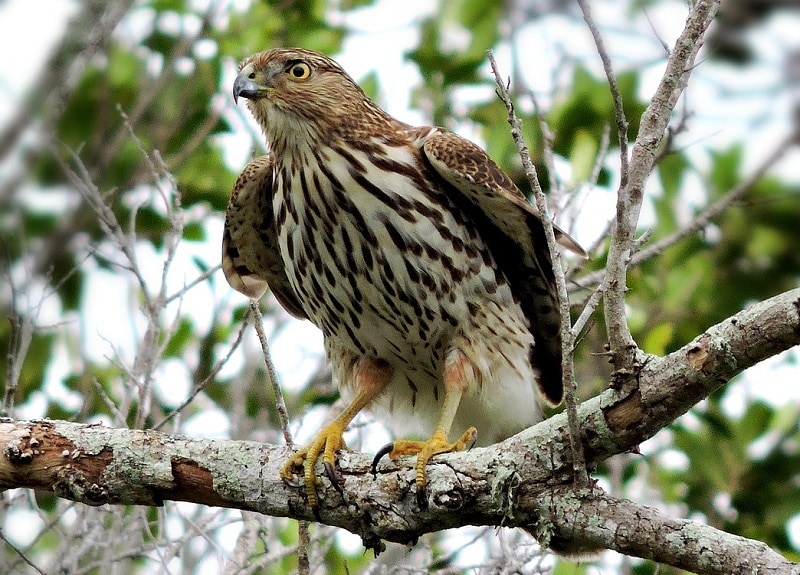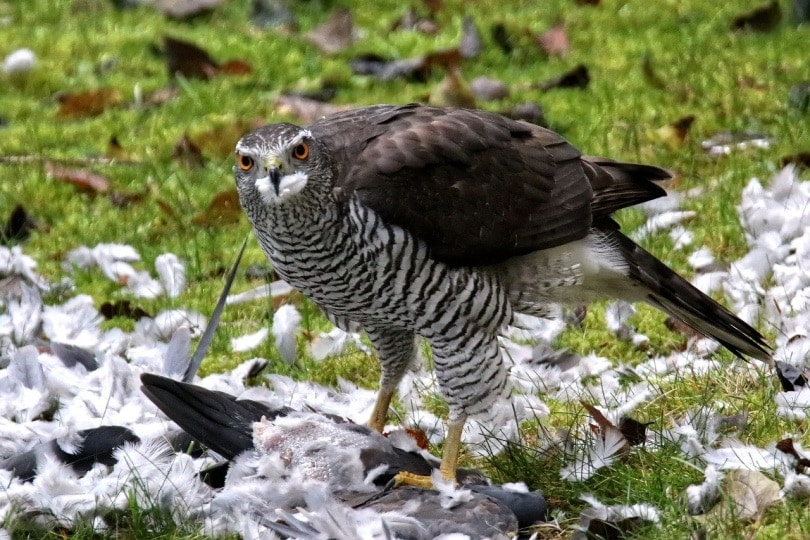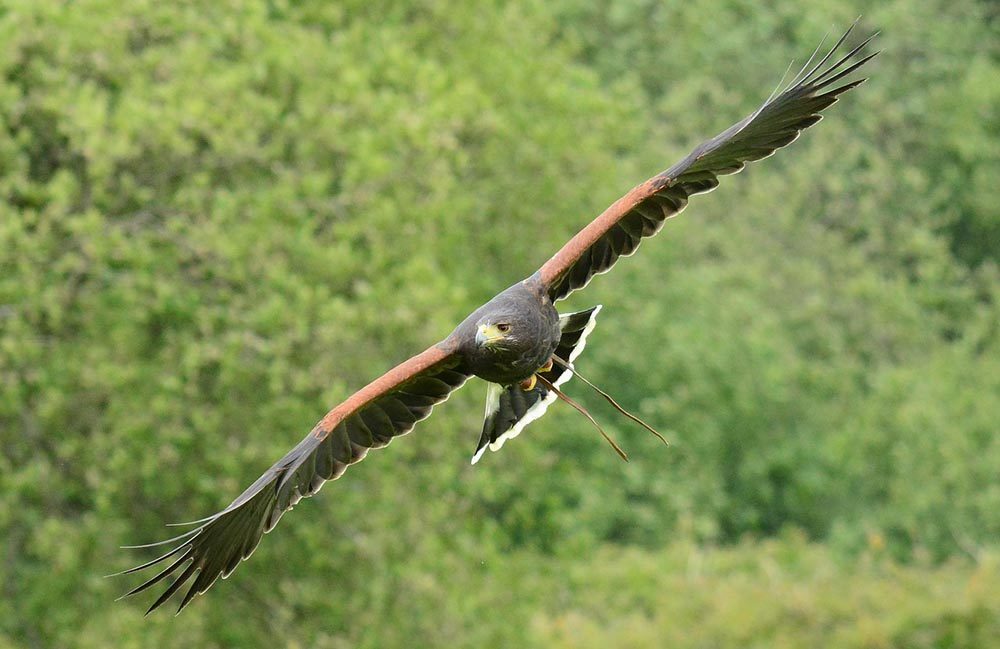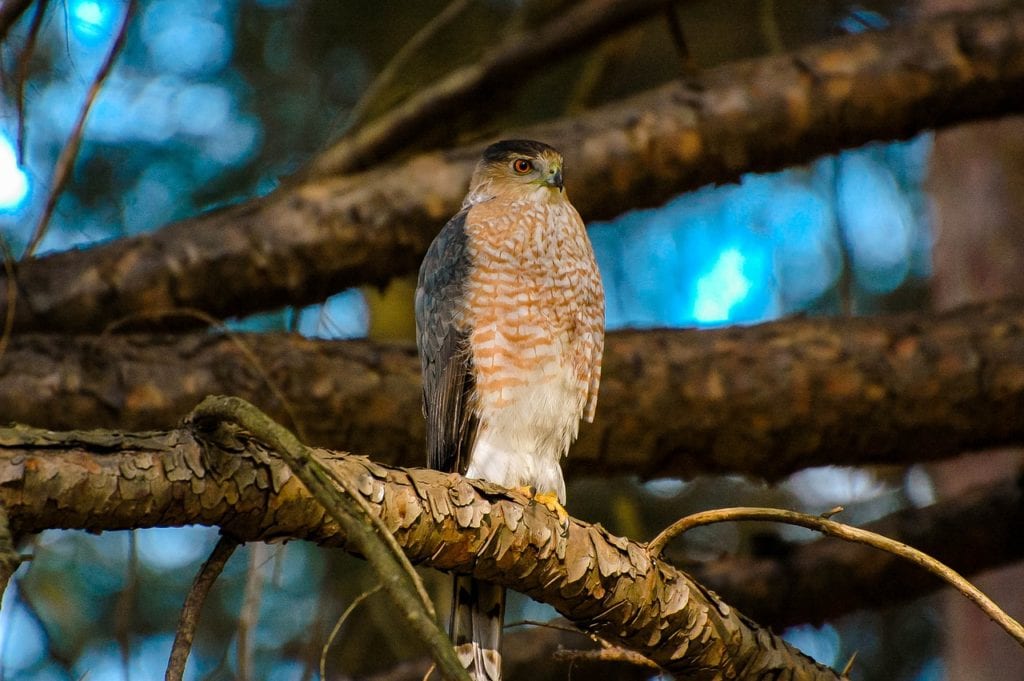Do Hawks Eat Birds? How Do Hawks Kill Other Birds?
Last Updated on

Hawks are one of the most skilled predators belonging to the category of raptors that encompasses a huge variety of birds of prey. They feed on a diverse diet of animals—one of which is birds. Certain species of hawks are more prone to eating birds compared to others, meaning you should keep your backyard secure if you have some chicken running around.
In this article, we will delve deeper into why hawks kill birds and how they go about it, as we provide the best tips to keep your pet birds safe from hawks.

Why Do Hawks Eat Birds?
Hawks are predatory animals, meaning they prey on meat from other animals. That said, birds are among the easiest sources of meat for the hawks.
During harsh weather conditions, alternative sources of food can be a challenge, especially during winter. In these conditions, it will be easier to hunt for birds as they will be higher upon the canopies and easier to reach with the hawk’s long talons.

What Else Do Hawks Eat?
Apart from birds, hawks have a diverse menu that ensures they always have something to eat. A hawk will need food amounting to between 12% and 15% of its body weight daily to stay healthy. Larger types of hawks like the Cooper’s hawk will eat more than a pound. They may not be able to carry a child away, but your smaller pets, like a puppy or rabbit, are at risk.
Some of the food the animals the hawk will eat include the following:
- Rodents
- Fish
- Poultry
- Turtles
- Frogs
- Snakes
- Lizards
- Squirrels
- Voles
- Insects

Which Birds Do Hawks Eat?
There are over 200 species of hawks in the world. Around 99% of them choose birds as part of their diet, and around 100 species have been proven to feed exclusively on birds.
There are around 500 species of small and medium-sized birds that hawks will feed on. For the smaller kinds of hawks, the most preferred birds for food include:
- Songbirds
- Sparrows
- Finches
- Quails
- Owls
- Young birds
For the bigger kinds of hawks, the most preferred birds for food include:
- Pigeons
- Tinamous
- Doves
- Crows
- American wigeon
- Ravens
- Northern screamers
- Ducks
- Hens

They will consume their prey on the spot after catching it or carry it to its nest.
Which Kinds of Hawks Eat Birds?
In the U.S., the most predominant bird hunters include:
- Cooper’s hawk
- Sharp-shinned hawks
- Northern goshawks
Although there are plenty more such as the American kestrel, these are the ones you should be most wary of.
Adaptations of a Hawk To Hunting Prey
Several adaptations have resulted in hawks having an advantage over their prey, especially other birds. Let’s take a look at some of these:
Eyesight
Hawks come with some of the sharpest eyesight in the world, which is up to eight times better than that of humans. This means the hawk can spot prey from way up in the sky and follow its movements as it prepares for a kill.

Hearing Capability
Hawks have a sharp sense of hearing and can hear even small animals scurrying in the bushes from way up.
Physique
Hawks have darkish brown feathers with reddish-brown plumage that helps them blend well within the canopies without their prey spotting them. They are also quite big, measuring between 18–30 inches and weighing between 26–37 ounces. They can easily overpower their target prey.
Females are at times bigger than males and prefer tropical and grasslands type of landscapes. They will also thrive well in savannas, semi-deserts, scrubland, and wetlands.
Wings and Flight
Hawks have huge wings that are nearly double the size of their bodies. They assist in flight and agility, helping the hawk to cover huge distances in a short time and kill or grab prey with ultimate precision.

Talons
One of the primary advantages hawks have is the talons which come as part of their adaptation to hunting. After sighting prey while in the air, the hawk will swoop down at unimaginable speeds, and on nearing the prey, it will outstretch its feet and show its talons in readiness to grab the prey.
Talons are huge and curved to better grab the prey. It enables them to easily pierce or tear through flesh while at the same time acting as the perfect deterrent to any threats on the hawk.
Beak
Hawks also have sharp, strong beaks that help them tear into flesh as they devour their prey. It is an important tool in pre-digestion and will help reduce the size of flesh it takes in.

What Time Do Hawks Hunt for Prey?
Most hawks will hunt either during dusk or dawn. They are diurnal creatures who can as well hunt during the day but they choose during dusk or dawn as it is easier to spot and sneak on the prey. They do not see well at night but can still feed at night if they have dead prey. They have eight times better vision compared to humans.

How Do Hawks Hunt?
Hunting As a Team
Certain kinds of hawks, especially the Harris hawks, will hunt as a team, increasing the chances of getting a kill due to coordinated efforts.
One team will drive the prey into the beaks of the other team through a chase. The technique, although unfamiliar to most other hawks, helps the Harris hawk get food without using too much energy.
Low Flight
This is mostly done in open habitats where the hawk will fly closer to the ground in a straight line. The style is effective in terms of fast movements, where they prey on seeing the fast-moving raptor will scurry away, thus exposing itself to the hawk.
Hover and Pounce
The hawk will search slowly for prey while flying low and ensure the prey has no idea of its presence. It will then hover on top of it and dive down fast to pounce.

Perch and Swoop
Here, the hawk selects a good resting area with a view of the whole hunting ground and stays watch, waiting for prey. Once it shows itself, the hawk will then swoop down for the kill.
High Soaring
Hawks can also use the high soaring method, which confuses the prey as to the position of the hawk and the direction it should run to. The hawk will then swoops on the prey and grab it.
Aerial Pursuit
You may not be aware, but hawks also hunt for other birds in the air, grabbing them while in flight. The chase will happen mid-air, which will require a lot of agility and acrobatics, but is another common way hawks hunt.

Protect Your Birds From a Hawk Attack
There are ways you can ensure your birds and small rodents are protected in your backyard without posing any threat to the hawk.
Some of these ways include:
Remove Feeders
If you feed birds in your backyard, you may be attracting unwanted attention from hawks, as they may use your place as a hunting ground for birds coming to feed on the birdfeed. Remove all feeders for around two weeks to discourage the hawks, so they can find new hunting grounds.
After you return the feeders, smaller birds may be quick to come back and attract a hawk or two. However, hawks will rarely come back to a failed hunting ground.

Protect Windows
A stunned bird is easy prey; it may result in its demise. Use certain tools such as decals to prevent window collisions by smaller birds that may fly into them if surprised by a hawk.
It will also help prevent any danger to the hawk as it hunts around your home.
Cage Feeders
You can use cage feeders as they will help protect smaller birds as they feed. The feeder has a cage that certain sizes of animals can fit, allowing them to safely come in, eat and leave without posing any risk to the birds.
If a hawk approaches the cage and tries to grab the small bird, the bird will be protected because the hawk will not fit in.
Remove Hawk Vantage Points
Hawks in such scenarios as backyards will try and perch up somewhere as they assess the hunting ground waiting for an opportunity. The best option is to remove such branches and areas a hawk may use as a vantage point.

Frequently Asked Questions
- Do hawks choke their prey?: Hawks will use their strength and talons to effectively choke the prey till it dies of suffocation or organ puncturing.
- How fast are hawks?: The red-tailed hawk has been known to dive at speeds of around 120 miles an hour. At this speed, if they set eyes on a certain bird for prey, it will not escape.
- Do hawks attack humans?: Hawks do not pose a threat to humans, but if you go near their nests, you will be in for a shock.
- How do birds know a hawk is around?: If one bird spots a hawk, it will let out an alarm warning all the other birds around to go into hiding.

In Conclusion
It is part of the normal cycle of life for hawks to eat birds, but they also prey on other animals. You may choose to protect your small birds from hawks, but always remember not to hurt the hawk as it is in its normal course of food hunting.
Featured Image Credit: amberdawn1111, Pixabay
About the Author Ed Malaker
Ed Malaker is a veteran writer who contributes to a wide range of blogs covering information on computer programming, pets, birding, tools, fitness, guitars, and optics. Outside of writing, Ed is often found working in the garden or performing DIY projects in the house. Ed is also a musician, spending his time composing music for independent films or helping people repair their guitars.
Related Articles:
10 Types of Hummingbirds in Arkansas (With Pictures)
8 Types of Hummingbirds in Nebraska (With Pictures)
5 Types of Hummingbirds in Idaho (With Pictures)
3 Types of Hummingbirds in Mississippi (With Pictures)
8 Types of Hummingbirds in Kansas (With Pictures)
5 Types of Hummingbirds in West Virginia (With Pictures)
5 Types of Hummingbirds in Ohio (With Pictures)
Where Do Nuthatches Nest? Nuthatch Nesting Habits Explained
